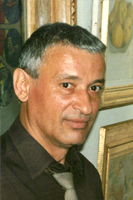|
About the artist "Dimitrie Gavrilean confers a plastic body to a "Romanian cosmogony" based on the deciphering of people's myths, re-introduced now in a cipher system, visual of prescribed art and personnel at the same time, not collective one, but descending from the Romanian Middle Ages." Ion Frunzetti,
"In the tradition search", Meridiane Publishing House, 1998
"Gavrilean creats ample narrative compositions in which he includes the life of a village with its customs and traditions, offering numerous characters of various attitudes, but all of them taking part in the same rich social life." Petru Comarnescu
"Descending from the legend world of Voronet where he was born, Dimitrie Gavrilean brings into painting the fancifulness of folk tales and beliefs, which he masters by means of a rigorously organized painting. Charged by symbols Gavrilean's painting is an anthology of the people's wisdom transposed into myth and wisdom which phantoms and superstitions threaten but do not succeed to destroy it." Vasile Dragut "The artist has a profound sense of the ensemble, the composing architecture possesses an incontestable force, without rejecting the anecdote he submits it to the rigorously of a well-formed construction, as in the Dutch Renaissance, on a dissimulated geometry. It is a world of the miracle and another one of the reality merged into a full of charm chromatic vision." Dan
Grigorescu
“Gavrilean, a mysterious talent, arrived from Iasi wrapped up by the train of that wonderful literature which we know very well, underlined in these extraordinary paintings that I did not cease in beholding them. A great painter, as I have already told, from the beginning." Eugen
Barbu
The density of paints superposed with patience worthy of the medieval artists forms, at first sight, a semi-dark curtain hiding the entrance to the tunnels leading to ancient times - as Dimitrie Gavrilean's works appear. Strongly capturing the viewer's look, the curtains are going up slowly, like vapour dissipating without notice thus revealing unexpected views in which a light from other worlds filters, radiating from a strange sun which can lighten, by means of shining white, mysterious corners of what might have had the appearance of complete dark monochromies. The insensible transition from one tone to another forces the eye to explore willy-nilly each and every inch of the painting, discovering fragments put together in a mysterious universe saturated with forms which participate in something that drags you more and more to the bottom. The fascination exerted by Gavrilean's paintings comes not only from their great artistry but also from his deep arcane thinking aiming at a unitary image of the world. The joints of this unknown world are shown with the shy understanding of secrets worth whispering gradually and solemnly revealed while guarding rituals never to be completely understood. Little by little you sink in the past of trans-reality elaborated by the fantasy of the archaic layer of the traditional European mentality. Dimitrie Gavrilean's paintings find themselves beyond the folklore which is looked upon more and more conventionally and emptied of its live substance; they are to be found in the conceptual area of the medieval thinking. In a way, they are the replica over the centuries of the frescoes painted on the walls of the buildings erected during the glorious Moldavian past integrated in their turn into the thinking of the European Middle Age of eastern stamp. The age of the layer of thinking in which the painter's expressive force develops , descending from the XXth century Voronetz (a mere strange coincidence?) can be traced even in the white of the clothes worn by his characters, which is most often mistaken for a Romanian folk feature. When this happens, people forget that the white, the long white man shirt and the woman veils were garments common to Europeans from certain old times. No matter who the viewers are, Romanians or western Europeans, they all can understand the significance of Dimitrie Gavrilean's paintings since they ascribe to them a general meaning as an expression of the whole mundane European image. The painter's works speak in a universal human language about happenings belonging to a world which continues to live in the collective way of thinking of the European peoples. The happenings are reinforced over the centuries by retellings and "livresque" interpretations supplied at the same time by the common memory. "The Gathering of the Wise" or "The Gathering of the Mad" in flying carts symbolizing time passing, "The "Arch of the Sky" from "Self-portrait" are images to be fully understood even in their mysterious aura. "The Wedding", "The Ritual Hunting", "The Miraculous Sowing", "The Miraculous Harvest" , " Song of the Songs " are metaphorical moments of an old human experience sometimes transfigured by the poetic myths coming from the same experience, rendered through the gift of colour of a contemporary of ours. The return to the ancient times is done by a modern artist who feels the urge for decanted certainties over the centuries, and the poetry of the fantastic is one of these certainties. In the sky painted by Gavrilean, a sky as consistent as the earth itself, creatures float and entities that can turn into anything surround ecstatic people gathered in large groups , officiating. The universe of the sky is suspended, while the villages of the real people, who cannot be seen, are lost somewhere in the distance. It is an inversion of the sky and the earth which disappears where the painting ends and the real world begins. The images come one after another in a row which claims for a never ending investigation; Dimitrie Gavrilean's outstanding imagination generates no fear but freedom of movement and thought in a world created by the force of the human mind. Paul Petrescu
- "Archways through Time", 1987 |
|||||||||||
designed
by Dragos Iustin Gavrilean |
||||||||||||
